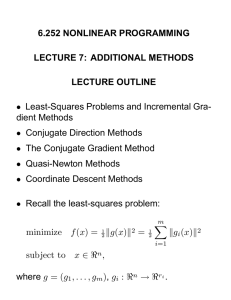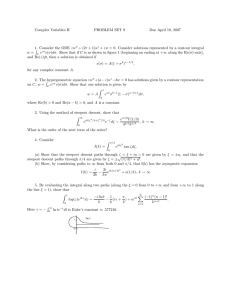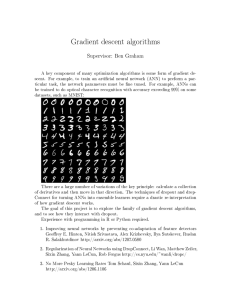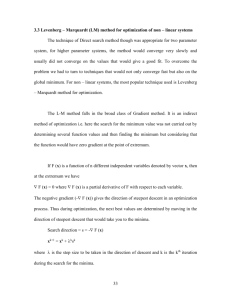Document 13564170
advertisement
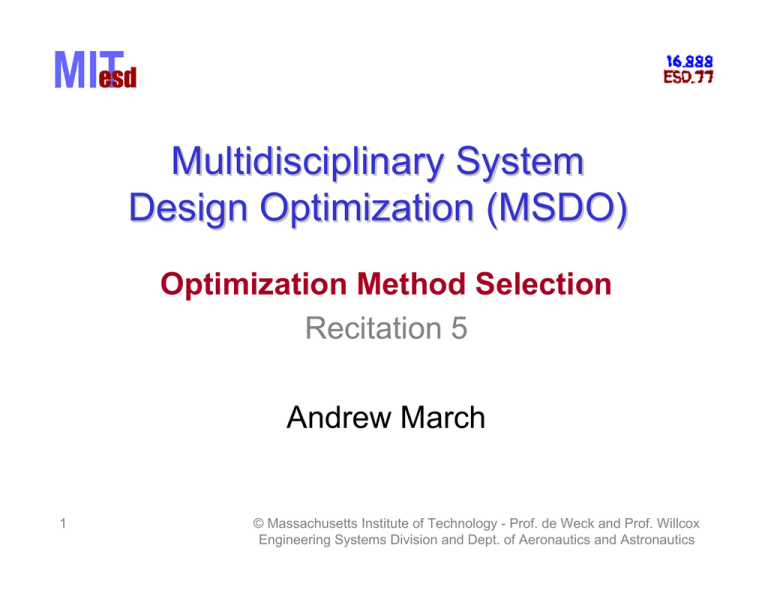
Multidisciplinary System
System
Design Optimization (MSDO)
(MSDO)
Optimization Method Selection
Recitation 5
Andrew March
1
© Massachusetts Institute of Technology - Prof. de Weck and Prof. Willcox
Engineering Systems Division and Dept. of Aeronautics and Astronautics
Today’s Topics
Topics
• Review optimization algorithms
• Algorithm Selection
• Questions
2
© Massachusetts Institute of Technology - Prof. de Weck and Prof. Willcox
Engineering Systems Division and Dept. of Aeronautics and Astronautics
Analytical Methods
• Gradient Based:
–
–
–
–
Steepest descent
Conjugate Gradient
Newton’s Method
Quasi-Newton
• Direct Search:
– Compass search
– Nelder-Mead Simplex
• Note: The gradient methods have a constrained
equivalent.
– Steepest Descent/CG: Use projection
– Newton/Quasi-Newton: SQP
– Direct search typically uses barrier or penalty methods
Gradient Methods
• Compute descent direction, dk
• Compute step length αk
• Take step: x k +1 = x k + α k d k
• Repeat until αkdk≤ε
Steepest Descent
• Compute descent direction, d k = −∇f (x k )
• Compute step length, αk
– Exactly: α k = arg min f (x k + αd k )
α
– Inexactly: any αk such that for a c1,c2 in (0<c1<c2<1)
T
f (x k + α k d k ) ≤ f (x k ) + c1α k ∇f (x k ) d k
∇f (x k + α k d k ) d k ≥ c2∇f (x k ) d k
T
• Take step: x k +1 = x k + α k d k
• Repeat until αkdk≤ε
T
Conjugate Gradient
• Compute descent direction, d k = −∇f (x k ) + β k d k −1
T
T
∇f (x k ) ∇f (x k ) or
∇f (x k ) (∇f (x k ) − ∇f (x k −1 ))
β =
β =
k
∇f (x k −1 ) ∇f (x k −1 )
k
T
∇f (x k −1 ) ∇f (x k −1 )
T
• Compute step length, αk
– Exactly: α k = arg min f (x k + αd k )
α
– Inexactly: any αk such that for a c1,c2 in (0<c1<c2<1)
T
f (x k + α k d k ) ≤ f (x k ) + c1α k ∇f (x k ) d k
∇f (x k + α k d k ) d k ≥ c2∇f (x k ) d k
T
• Take step: x k +1 = x k + α k d k
• Repeat until αkdk≤ε
T
Newton’s Method
• Compute descent direction, d k = −H −1 (x k )∇f (x k )
• Compute step length, αk
– Try: αk=1, decrease? If not:
(
)
• Exactly: α k = arg min f x k + αd k
α
• Inexactly: any αk such that for a c1,c2 in (0<c1<c2<1)
f (x k + α k d k ) ≤ f (x k ) + c1α k ∇f (x k ) d k
T
∇f (x k + α k d k ) d k ≥ c2∇f (x k ) d k
T
• Trust-region: α k d k ≤ Δ k
• Take step: x k +1 = x k + α k d k
• Repeat until αkdk≤ε
T
Quasi-Newton
• Compute descent direction, d k = −B −1 (x k )∇f (x k )
B (x k ) ≈ H (x k ); B (x k ) f 0
• Compute step length, αk
– Try: αk=1, decrease? If not:
(
)
• Exactly: α k = arg min f x k + αd k
α
• Inexactly: any αk such that for a c1,c2 in (0<c1<c2<1)
f (x k + α k d k ) ≤ f (x k ) + c1α k ∇f (x k ) d k
T
∇f (x k + α k d k ) d k ≥ c2∇f (x k ) d k
T
• Take step: x k +1 = x k + α k d k
• Repeat until αkdk≤ε
T
Direct Search, Compass Search
Δk
xk-Δkei
• Evaluate f (x k ± Δ k ei ), ∀i
• If f (x k ± Δ k ei ) < f (x k )
xk+Δkej
xk
xk-Δkej
– Move to minimum of: f (x k ± Δ k ei ), ∀i
• Else
1
– Δ k +1 = Δ k
2
xk+Δkei
Direct Search, Nelder-Mead
Generate n+1 points in ℜn, {x1,…,xn+1}
Iterate:
f (x )
• x l = arg min
x
f (x )
• x h = arg max
x
• x = centroid{x1 ,K, x n+1}
• Reflect (α>0): x r = (1 + α )x − αx h
• if ( f (x l ) < f (x r ) and f(x r ) < f (x h )), x h = x r , return
• if ( f (x r ) < f (x l )), Expand (γ>1): x e = γx r + (1 − γ )x
if ( f (x e ) < f (x l )), x h = x e , return
•
else, x h = x r , return
•
• if ( f (x r ) > f (x h )), Contract (0<β<1): x c = βx h + (1 − β )x
if ( f (x c ) ≤ min{ f (x h ), f (x r )}), x h = x c , return
•
else, x i = (x i + x l ) / 2, ∀i
•
i
i
J. A. Nelder and R. A. Mead, A simplex method for function minimization, Computer Journal,
Vol. 7, pp 308-313, 1965.
Heuristic Methods
•
•
•
•
•
Simulated Annealing
Genetic Algorithms
Particle Swarm Optimization (next lecture)
Tabu Search (next lecture)
Efficient Global Optimization
Simulated Annealing
•
Terminology:
–
–
–
–
•
X (or R or Γ) = Design Vector (i.e. Design, Architecture, Configuration)
E = System Energy (i.e. Objective Function Value)
T = System Temperature
Δ = Difference in System Energy Between Two Design Vectors
The Simulated Annealing Algorithm
1) Choose a random Xi, select the initial system temperature, and specify the
cooling (i.e. annealing) schedule
2) Evaluate E(Xi) using a simulation model
3) Perturb Xi to obtain a neighboring Design Vector (Xi+1)
4) Evaluate E(Xi+1) using a simulation model
5) If E(Xi+1)< E(Xi), Xi+1 is the new current solution
6) If E(Xi+1)> E(Xi), then accept Xi+1 as the new current solution with a
probability e(- Δ/T) where Δ = E(Xi+1) - E(Xi).
7) Reduce the system temperature according to the cooling schedule.
8) Terminate the algorithm.
Genetic Algorithm
Initialize Population (initialization)
next generation
Select individual for mating (selection)
Mate individuals and produce children (crossover)
Mutate children (mutation)
Insert children into population (insertion)
n
Are stopping criteria satisfied ?
y
Finish
13
Ref: Goldberg (1989)
© Massachusetts Institute of Technology - Prof. de Weck and Prof. Willcox
Engineering Systems Division and Dept. of Aeronautics and Astronautics
Particle Swarm • Birds go in a somewhat random
direction, but also somewhat follow a
swarm
• Keep checking for “better” locations
– Generally continuous parameters only, but
there are discrete formulations.
Tabu Search
• Keep a list of places you’ve visited
• Don’t return, keep finding new places
Efficient Global Optimization
• Started by Jones 1998
• Based on probability theory
– Assumes:
f (x) ≈ β Tx + N (μ (x), σ 2 (x) )
•
β T x , true behavior, regression
2
(
N
μ
(x),
σ
(x) ) , error from
•
true behavior is normally
distributed, with mean μ(x), and
variance σ2(x)
• Estimate function values with a
Kriging model (radial basis
functions)
– Predicts mean and variance
– Probabilistic way to find optima
• Evaluate function at “maximum
expected improvement
location(s)” and update model
What’s good algorithm?
Objective Contours:
•
•
•
•
•
•
•
•
•
•
•
•
Steepest descent
Conjugate gradient
Newton’s Method
Quasi-Newton
SQP
Compass-Search
Nelder-Mead Simplex
SA
GA
Tabu
PSO
EGO
What’s good algorithm?
f (x) = 100(x2 − x
) + (1 − x )
2 2
1
2
1
•
•
•
•
•
•
•
•
•
•
•
•
Steepest descent
Conjugate gradient
Newton’s Method
Quasi-Newton
SQP
Compass-Search
Nelder-Mead Simplex
SA
GA
Tabu
PSO
EGO
What’s good algorithm?
Objective Function:
a) Find quick improvement?
b) Find global optima?
•
•
•
•
•
•
•
•
•
•
•
•
Steepest descent
Conjugate gradient
Newton’s Method
Quasi-Newton
SQP
Compass-Search
Nelder-Mead Simplex
SA
GA
Tabu
PSO
EGO
What’s good algorithm?
• x1={1,2,3,4}
• x2∈ℜ
• min f(x1,x2)
•
•
•
•
•
•
•
•
•
•
•
•
Steepest descent
Conjugate gradient
Newton’s Method
Quasi-Newton
SQP
Compass-Search
Nelder-Mead Simplex
SA
GA
Tabu
PSO
EGO
What’s good algorithm?
•
Airfoil design with CFD
– Run-time~3 hours
a) Without an adjoint
solution?
b) With an adjoint solution?
•
•
•
•
•
•
•
•
•
•
•
•
Steepest descent
Conjugate gradient
Newton’s Method
Quasi-Newton
SQP
Compass-Search
Nelder-Mead Simplex
SA
GA
Tabu
PSO
EGO
What’s good algorithm?
• Minimize weight
– s.t. stress<σmax
• Natran output
– Stress=3.500x104
– (finite precision)
•
•
•
•
•
•
•
•
•
•
•
•
Steepest descent
Conjugate gradient
Newton’s Method
Quasi-Newton
SQP
Compass-Search
Nelder-Mead Simplex
SA
GA
Tabu
PSO
EGO
What’s good algorithm?
• Flat section:
•
•
•
•
•
•
•
•
•
•
•
•
Steepest descent
Conjugate gradient
Newton’s Method
Quasi-Newton
SQP
Compass-Search
Nelder-Mead Simplex
SA
GA
Tabu
PSO EGO What’s good algorithm?
min cTx
s.t. Ax=b
•
•
•
•
•
•
•
•
•
•
•
•
Steepest descent
Conjugate gradient
Newton’s Method
Quasi-Newton
SQP
Compass-Search
Nelder-Mead Simplex
SA
GA
Tabu
PSO
EGO
What’s good algorithm?
Nonsmooth objective:
•
•
•
•
•
•
•
•
•
•
•
•
Steepest descent
Conjugate gradient
Newton’s Method
Quasi-Newton
SQP
Compass-Search
Nelder-Mead Simplex
SA
GA
Tabu
PSO
EGO
What’s good algorithm?
Islands of feasibility:
x2
x1
=feasible
•
•
•
•
•
•
•
•
•
•
•
•
Steepest descent
Conjugate gradient
Newton’s Method
Quasi-Newton
SQP
Compass-Search
Nelder-Mead Simplex
SA
GA
Tabu
PSO
EGO
What’s good algorithm?
• Problem aspects:
– Islands of feasibility
– Many local minima
– Mixed
discrete/continuous
variables
– Many design variable
scales (10-1Æ104)
– Long function evaluation
time (~2 minutes)
•
•
•
•
•
•
•
•
•
•
•
•
Steepest descent
Conjugate gradient
Newton’s Method
Quasi-Newton
SQP
Compass-Search
Nelder-Mead Simplex
SA
GA
Tabu
PSO
EGO
Example: Operational Design Space
•
Objectives
– Time to Climb, Fuel Burn, Noise, Operating Cost
•
Parameters
–
–
–
–
–
–
•
Flap setting
Throttle setting
Velocity Transition Altitude
Climb gradient*
18 Total
Constraints:
– Regulations
• No pilot input below 684 ft
• Initial climb at V2+15kts
– Flap settings
– Velocity • Min: stall
• Max: max q
– Throttle
• Min: engine idle or positive rate
of climb
• Max: full power
Velocity
known
Fl
Flap
setting
known
Example:Design Space Exploration Methods
•
Exploration Challenges
–
–
–
–
–
•
Islands of feasibility
Many local minima
Mixed discrete/continuous variables
Many design variable scales (10-1Æ104)
Long function evaluation time (~2 minutes with noise)
Sequential Quadratic Programming [Climb time: 312 s]
– Stuck at local minima
– Can’t handle discrete integers
•
Direct Search (Nelder-Mead) [Climb time: 319 s]
– Similar problems as SQP, but worse results
•
Particle Swarming Optimization [Climb time: 319 s]
– Slow running (8-12 hours), optimum not as good as Genetic Algorithm
•
Genetic Algorithm [Climb time: 308 s]
– No issues with any of the challenges of this problem.
– No convergence guarantee and SLOW! Run-time ~24 hours.
– But, best result.
Summary
• You have a large algorithm toolbox.
• You can often tell by inspection what
algorithm might work well.
• Always take advantage of aspects of
your problem that will speed
convergence.
MIT OpenCourseWare
http://ocw.mit.edu
ESD.77 / 16.888 Multidisciplinary System Design Optimization
Spring 2010
For information about citing these materials or our Terms of Use, visit: http://ocw.mit.edu/terms.

